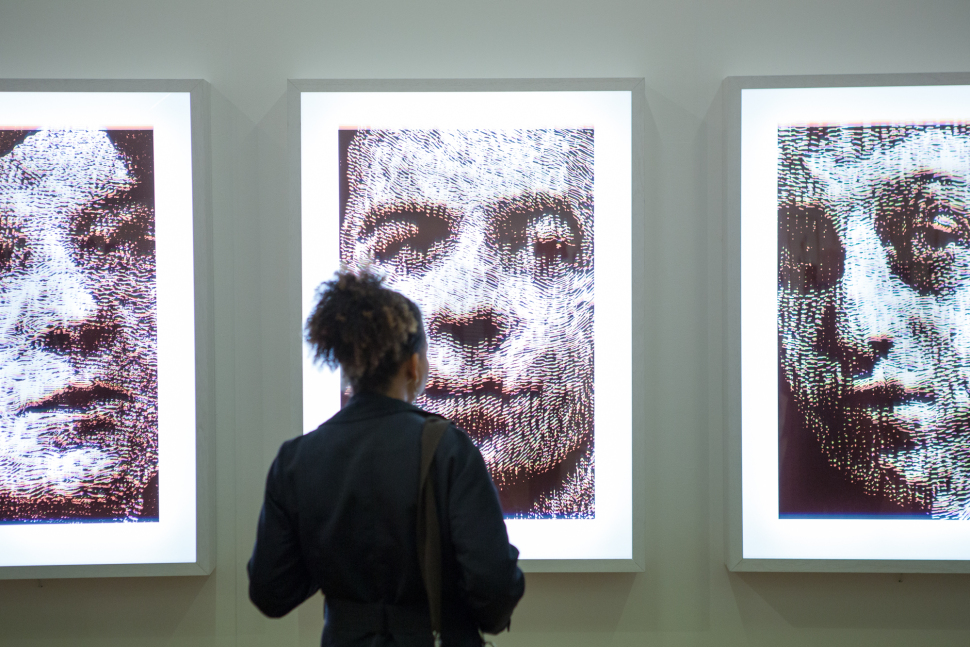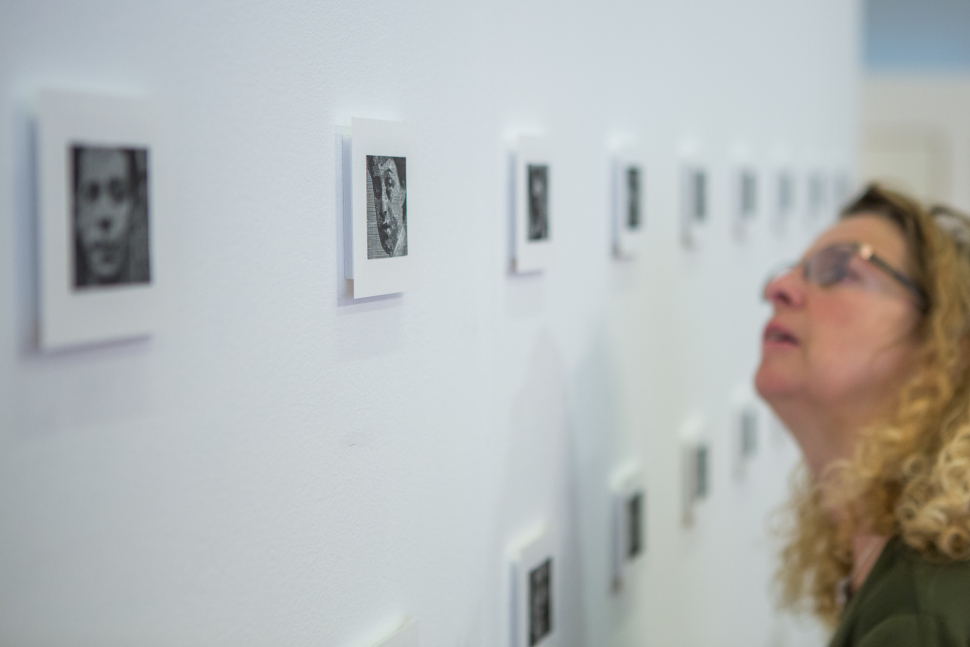PRINT UNLTD AT SALFORD MUSEUM AND ART GALLERY
Published June 27, 2018 by cottononmcr in Exhibition Review
Well done to the guys that promoted the Print UnLtd exhibition, this is one of the busiest private views we have been to in a long time! It was actually packed. This may have something to do with the ‘tickets’ they sent out to people. We received ours through the post which was a treat! I feel like once you have a physical ticket, you feel obliged to go to said event. That’s not to say that we didn’t want to go, or that you should need a ticket to go to a private view, but it just adds that extra bit of specialness to it I think. Anyway, I digress. Here’s my review of the exhibition which includes artists Claudia Alonso, Joey Collins, Gwilym Hughes and Lubna Ali.
Let’s start with Gwilym Hughes, ‘Salford Faces’. You are hit with a triptych of light boxes, each showing a different face. They look like blown-up etchings, with two colours added which gives it an almost 3D effect. Standing close to the images, they are too blown up for you to recognise the faces, but when you stand back it’s a totally different story, you see the emotion in each one. They each have a ‘Mona Lisa’ smile about them, hiding something behind the features.
Alongside the huge triptych, there are a series of tiny prints, about the same size as a Polaroid. These faces look like they have been taken from a history book, like they were passengers on the Titanic. There’s a mix of classes, right from Rose DeWitt Bukater through to Jack Dawson.
If you follow the blog you may know why I dislike Artists Statements, but as a person who reviews art, I know I need to read them. So, after writing the above I have now read the statement and found out that these faces are from the Salford Local History Library based at the Salford Museum and Art Gallery, so they are historic! ‘The artist gives new lives to people who may not know they were having their picture taken, and may have never seen the resulting photographs.’
I was pretty impressed by Print UnLtd, and this was my first time in Salford Museum and Art Gallery – which is a weird venue but that’s another story. So yes, this exhibition is definitely worth the visit. The work is modern, different, and not restricted by any set theme. You can simply appreciate each artists’ work and enjoy the different forms of print. For an exhibition that is supposed to ‘challenge and question perceived constricts and rules around printmaking’, I think they have done it and done it well. Oh, one last thing, the caterers need a mention too, those cheese and beetroot tarts were divine!
Print UnLtd is on at Salford Museum and Art Gallery and runs till 14th October.
Making Marks by Hand: Exhibition Review
Editions Ltd’s new exhibition, featuring the work of Fred Jones and Gwilym Hughes, addresses an interesting issue that I have been mulling on for a while. It is an issue around printing, and saleability. When you enter a sales gallery you expect some digital reproductions of work to be on sale amongst large original paintings – more often than not in full colour. It’s surprisingly rare to come across work that is entirely monochrome and manually printed using relatively old fashioned techniques.
It might sound fair enough. Who wants black images on their wall? But these printing techniques of etchings, engravings and woodblock printing are very much coming back into fashion within arts education. So why are they not commonplace on gallery walls?
Well the simple fact is, they’re very often mistaken for working drawings and don’t feel like finished work. Hughes and Jones’ prints and etchings displayed in the intimate gallery on Cook Street are brilliantly accomplished pieces of print work that stand out as very finished indeed, and more worthy than the vast majority of painting to adorn a gallery wall.
Gwilym Hughes’ prints focus on people, whether famous or not, with a lens on how they are seen by those around them. Drawing on memories and histories that need recording in unconventional ways. Whether that is because of how they are perceived or, in Flamenco Faces, the entirely practical reason that sound and photography recordings weren’t all that great once upon a time. What really intrigued me though, was the method in which these prints have been produced. Woodcuts are woodcuts, it might seem, but to Gwilym Hughes woodcuts tell their own story as a process, not just an outcome – and that story is highly visible in the quality of the final prints.
Using reclaimed wood, he follows standard wood cutting techniques, and maybe intentionally, maybe unintentionally, creates a new level to the work that compliments his primary interest in human character; a statement I should probably expand on a little. If you look at the history of the technique, it was a way of producing unlimited edition prints. You carve out your pattern in hardwood, sand it, treat it, sand it again, and create a solid, weatherproof printing block that will give you a perfect print every time.
When you follow that process with old wood, it leaves marks, and those marks build up more ink, and change the print – so even in a limited edition run, there will be subtle but noticeable differences. It’s hard to follow, but that’s what makes these prints special. Tiny but critical differences, which mirror their human subjects in all their difference.
Patrick Kirk-Smith
What’s your background and how did you get into printmaking?
I’m a printmaker, graphic designer and sometime musician living in Manchester. As a designer I’ve spent years working on computers, and as a reaction have the need to make my own marks doing something very hands-on, low-tech and time consuming.
What inspires your work?
Human character and how real people can become symbols of something else in other people’s minds. ‘Lost Voices’ is a collection of work that reflects my interest in music and words that were never recorded and are beyond living memory – a creative life now lost forever. The ‘Chance Meetings’ series deals with how real or imaginary characters can become players in our own internal dramas. We have a view of people from history that may have very little to do with their actual lives. They can become like the cast of a film played out in our own inner life. Therefore, there has to be an underlying element of autobiography in much of what I do. This shouldn’t be important to the viewer, but it does give me enough interest to invest the time it takes to make my prints.
Tell us more about your techniques.
I work mainly with woodcut and I like to use wood from dismantled pieces of old furniture (it comes with its own history), or pieces of plywood from the local builders yard – anything that’s tricky to work with, unpredictable and allows some kind of dialogue with the material. Some of my techniques are unconventional, I will steal any method I can make use of – from old copper engraving, Japanese woodblock etc. I tend not to use a press and burnish by hand, it’s time consuming but brings a hands-on control to every part of the process.
Who and what have been your influences?
I like looking at things, so most of what I see and experience is an influence of some kind. I love antique engravings – the time and skill it must have taken to reproduce an old master painting is staggering and we know very little, if anything, about the people who actually did this work. I admire Gustave Dore for his ability to create an intense and dramatic world with just lines, dots and ink. Rembrandt could create a world in a human face. I think my favourite recent printmaker is Leonard Baskin.



